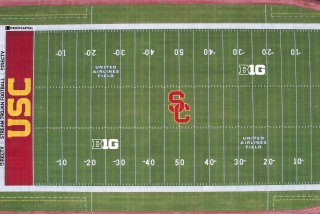USC gives some ground on Coliseum
USC has backed off its proposal to run the Coliseum, provided the stadium’s landlord takes responsibility for making significant improvements to the venue.
In a counterproposal issued by the school Monday, school officials suggested a four-year plan for the Coliseum Commission to significantly upgrade the 84-year-old stadium.
“It’s been our home for over 80 years,” said Todd Dickey, USC senior vice president and general counsel. “We have all our tradition and history in that facility, and it’s where our fans want to stay. It’s an important part of our culture, so it’s by far our first choice.”
By the school’s estimate, a sufficient overhaul of the stadium would cost about $50 million, or half of what USC offered to invest in the venue in a proposal submitted in June. That plan required the commission to hand day-to-day operations of the stadium to the school.
The nine-member commission, composed of representatives from the city, county and state, issued a proposal last week in which it agreed to give the school the right to veto any deal with the NFL. That is a significant concession.
USC’s counterproposal also would require that the commission adhere to a specific timetable to complete various renovations, and, if it cannot keep pace with those, that it give up control of the stadium to the school.
“At the end of the day, if we get an improved Coliseum, we, and the rest of Los Angeles, are better off for it,” said Kristina Raspe, USC associate senior vice president for real estate and asset management. “But if they are unable to do it, then we want the opportunity to do it. Because in the end, nobody wins if the Coliseum is left to deteriorate.”
The commission has scheduled a special meeting Wednesday to discuss the counterproposal -- the second consecutive week such a meeting has been called. USC detailed its offer during a news conference on campus Monday and posted the proposal documents on its website.
Pat Lynch, general manager of the Coliseum, said the commission was “a little surprised” the school would make public specific details of its counterproposal, “but this is part of the process. We’ve been going back and forth.”
Lynch declined to discuss the specifics of the USC proposal but characterized it as “positive movement.”
“It’s a main priority for all of us,” he said. “Both sides are making their best efforts to get this done.”
Another unresolved issue is the annual rent that the commission pays to the state, which owns the Coliseum. Both sides met Monday afternoon and were expected to come to an agreement on deal terms, a source familiar with the discussions said. But those terms will have to be approved by all the representatives from both parties, the commission and state.
Frustrated by the lack of progress on a long-term lease, USC has been exploring a two-year deal to play at the Rose Bowl, beginning next fall. Those talks will continue, Dickey said, until a deal with the commission is completed.
“We move forward concurrently,” he said in a phone interview. “We had discussions with UCLA [the Rose Bowl’s primary tenant] last week and will continue to have discussions with them.”
USC has been in discussions with the Pacific 10 Conference regarding scheduling issues in case it were to share a stadium with UCLA.
In terms of its negotiations with Coliseum officials, USC has budged on a major sticking point. It has relaxed its position somewhat on the issue of naming rights, saying it would allow the use of USC’s name and logos under the right circumstances.
“In the interest of getting a deal done we have . . . agreed to allow the commission to do a naming-rights deal and cooperate with the commission to get a single, prime naming-rights sponsor to name the Coliseum and put together a package,” Dickey said. “As long as the money that was raised from that will go toward improving the Coliseum, based on the list of improvements that we feel are necessary and the specific deadlines by which they must be done.”
At the news conference, Dickey said the counterproposal stipulates that video boards, scoreboards and the sound and lighting systems must be replaced within one year of the commission’s signing the agreement. The escalator and elevator systems also must be upgraded. Restrooms and concession stands must be improved by the end of Year 2.
By the end of Year 3, USC wants fencing around the stadium to be replaced and upgraded. In addition, all of the seating within the Coliseum must be replaced and all of the concrete that is crumbling must be repaired.
By the end of the fourth year, a state-of-the-art video board must be installed at the west end of the stadium, the locker rooms must be upgraded, the field drainage must be repaired and a new field must be installed.
Earlier in the day, Dickey said there was also a possibility the school could have representation on the commission.
“The commission has indicated they are in favor of that, and their proposal agreed to work toward that goal,” he said. “We’ve been in communication with state representatives and they want to work toward that goal. All the stars are aligned to make that happen.”
Dickey did not give a specific drop-dead date for the negotiations to be completed. However, he said, “Come spring, I’m sure it will be a pressing matter.”
More to Read
Go beyond the scoreboard
Get the latest on L.A.'s teams in the daily Sports Report newsletter.
You may occasionally receive promotional content from the Los Angeles Times.












